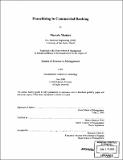| dc.contributor.advisor | Henry Birdseye Weil. | en_US |
| dc.contributor.author | Maziero, Marcelo, 1967- | en_US |
| dc.contributor.other | Sloan School of Management. | en_US |
| dc.date.accessioned | 2005-08-22T23:21:22Z | |
| dc.date.available | 2005-08-22T23:21:22Z | |
| dc.date.copyright | 2000 | en_US |
| dc.date.issued | 2000 | en_US |
| dc.identifier.uri | http://hdl.handle.net/1721.1/9183 | |
| dc.description | Thesis (S.M.)--Massachusetts Institute of Technology, Sloan School of Management, 2000. | en_US |
| dc.description | Title as it appears in MIT commencement exercises program, June 2000: Franchising of branches in commercial banking | en_US |
| dc.description.abstract | In the increasingly competitive environment faced by commercial banks at the retail segment of the market, one of the greatest challenges is to build and maintain an efficient and effective distribution channel, offering a superior quality of services to the customers, with low operational costs and minimum initial investment. Although apparently paradoxical, all these factors are crucial for a bank in getting and sustaining competitive advantage on such a highly competitive market. The focal point of this thesis is the proposition of the franchise system for the network of branches at commercial banks, as a way to dramatically reduce the constraints faced when trying to improve the distribution channel and, as an ultimate consequence, becoming more competitive. I firstly set the backdrop for the thesis in analyzing the importance of the distribution channel on the competitiveness of a commercial bank operating on the retail segment. The conclusion of this analysis is that the traditional model of growth using owned branches and ATM's has two main drawbacks. The first is the lack of flexibility in fitting the channels to the demand. The second is that it does not address the main constraints of growth: free capital to invest in growth and human resources with the desirable profile. With the backdrop set, I propose a set of alternative models of growth that are intended to increase flexibility (and eventually efficiency) of the distribution channels, and mainly to reduce the influence of the constraints on the growth and efficiency. Among these alternative model it is the franchise system. Most of the thesis is devoted to the description of the franchise model for commercial banks, with the relevant operational aspects of the interfaces between the bank and the franchisees, as well as the importance of the design of the incentives in order to fully achieve the potential benefits of the system. Complementing the description of the potential benefits and the risks in adopting the new system, I establish a set of actions to reduce those risks as well as the basic requirements a bank must meet before initiating the process of implementing the franchise system. | en_US |
| dc.description.statementofresponsibility | by Marcelo Maziero. | en_US |
| dc.format.extent | 83 leaves | en_US |
| dc.format.extent | 6285159 bytes | |
| dc.format.extent | 6284916 bytes | |
| dc.format.mimetype | application/pdf | |
| dc.format.mimetype | application/pdf | |
| dc.language.iso | eng | en_US |
| dc.publisher | Massachusetts Institute of Technology | en_US |
| dc.rights | M.I.T. theses are protected by copyright. They may be viewed from this source for any purpose, but reproduction or distribution in any format is prohibited without written permission. See provided URL for inquiries about permission. | en_US |
| dc.rights.uri | http://dspace.mit.edu/handle/1721.1/7582 | |
| dc.subject | Sloan School of Management. | en_US |
| dc.title | Franchising in commercial banking | en_US |
| dc.title.alternative | Franchising of branches in commercial banking | en_US |
| dc.type | Thesis | en_US |
| dc.description.degree | S.M. | en_US |
| dc.contributor.department | Sloan School of Management | |
| dc.identifier.oclc | 45450243 | en_US |
